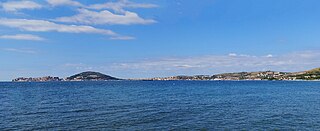
Gaeta is a city in the province of Latina, in Lazio, Southern Italy. Set on a promontory stretching towards the Gulf of Gaeta, it is 120 kilometres from Rome and 80 km (50 mi) from Naples.

The Duchy of Benevento was the southernmost Lombard duchy in the Italian Peninsula that was centred on Benevento, a city in Southern Italy. Lombard dukes ruled Benevento from 571 to 1077, when it was conquered by the Normans for four years before it was given to the Pope. Being cut off from the rest of the Lombard possessions by the papal Duchy of Rome, Benevento was practically independent from the start. Only during the reigns of Grimoald and the kings from Liutprand on was the duchy closely tied to the Kingdom of the Lombards. After the fall of the kingdom in 774, the duchy became the sole Lombard territory which continued to exist as a rump state, maintaining its de facto independence for nearly 300 years, although it was divided after 849. Benevento dwindled in size in the early 11th century, and was completely captured by the Norman Robert Guiscard in 1053.
The Battle of Garigliano was fought in 915 between Christian forces and the Saracens. Pope John X personally led the Christian forces into battle. The aim was to destroy the Arab fortress on the Garigliano River, which had threatened central Italy and the outskirts of Rome for nearly 30 years.

The Duchy of Gaeta was an early medieval state centered on the coastal South Italian city of Gaeta. It began in the early ninth century as the local community began to grow autonomous as Byzantine power lagged in the Mediterranean and the peninsula due to Lombard and Saracen incursions.
Richard Drengot was the count of Aversa (1049–1078), prince of Capua and duke of Gaeta (1064–1078).
Docibilis II was the ruler of Gaeta, in one capacity or another, from 906 until his death. He was the son of the hypatus John I, who made him co-ruler in 906 or thereabouts.
John I was the second hypatos of Gaeta of his dynasty, a son of Dociblis I and Matrona, and perhaps the greatest of medieval Gaetan rulers.
Landulf II (c. 825 – 879) was Bishop and Count of Capua. He was the youngest of four sons of Landulf I, gastald of Capua. As a young man, he entered the church. When his father died, his eldest brother, Lando, succeeded him.
Landulf I, sometimes called Antipater, was a Lombard nobleman and the Prince of Benevento and of Capua from 12 January 901, when his father, Atenulf I, prince of Capua and conqueror of Benevento, associated his with him in power.
Alberic I was the Lombard Duke of Spoleto from between 896 and 900 until 920, 922, or thereabouts. He was also Margrave of Camerino, and the son-in-law of Theophylact I, Count of Tusculum, the most powerful man in Rome.
Athanasius was the Bishop and Duke of Naples from 878 to his death. He was the son of Gregory III and brother of Sergius II, whom he blinded and deposed in order to seize the throne while he was already bishop.
Sergius I was the first duke of Naples of his dynasty, often dubbed the "Sergi," which ruled over Naples for almost three centuries from his accession in 840 until the death of his namesake Sergius VII in 1137.
The Drengots were a Norman family of mercenaries, one of the first to head to Southern Italy to fight in the service of the Lombards. They became the most prominent family after the Hautevilles.

The Principality of Capua was a Lombard state centred on Capua in Southern Italy. Towards the end of the 10th century the Principality reached its apogee, occupying most of the Terra di Lavoro area. It was originally a gastaldate, then a county, within the principality of Salerno.
Caesar the Brave was the admiral of the fleet of the Duchy of Naples during the reigns of his father, Sergius I, and brother, Gregory III.
Pandenulf was the Count of Capua, claiming that title from 862 and holding it successfully during the tumultuous civil war of 879 – 882. He was the son and successor of Pando, but was removed on his father's death by his uncle the bishop, Landulf II.

The Norman conquest of southern Italy lasted from 999 to 1194, involving many battles and independent conquerors.

The Frankish emperor Louis II campaigned against the Emirate of Bari continuously from 866 until 871. Louis was allied with the Lombard principalities of southern Italy from the start, but an attempt at joint action with the Byzantine Empire failed in 869. In the final siege of the city of Bari in 871, Louis was assisted by a Slavic fleet from across the Adriatic.

The siege of Salerno was one of the campaigns of the Aghlabids in southern Italy during their conquest of Sicily. The Lombard city of Salerno had strong defences and, despite the use of stone-throwing artillery, the siege lasted a little over a year from its beginning in late 871 or early 872. Prince Guaifer of Salerno led the defence, but the siege was only lifted by the arrival of an army of Lombards and Franks under the Emperor Louis II.






